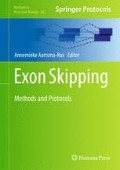Abstract
Numerous genetic disorders are caused by loss-of-function mutations that disrupt the open reading frame of the gene either by nonsense or by frameshift (insertion, deletion, indel, or splicing) mutations. Most of the time, the result is the absence of functional protein synthesis due to mRNA degradation by nonsense-mediated mRNA decay, or rapid degradation of a truncated protein. Antisense-based splicing modulation is a powerful tool that has the potential to treat genetic disorders by restoring the open reading frame through selective removal of the mutated exon, or by restoring correct splicing.
We have developed this approach for a severe genetic skin disorder, recessive dystrophic epidermolysis bullosa, caused by mutations in the COL7A1 gene encoding type VII collagen. This gene is particularly suited for exon-skipping approaches due to its unique genomic structure. It is composed of 118 exons, 83 of which are in frame. Moreover, these exons encode a single repetitive collagenous domain.
Using this gene as an example, we describe general methods that demonstrate the feasibility and efficacy of the antisense-mediated exon-skipping strategy to reframe transcripts.
Sandrina Turczynski and Matthias Titeux have contributed equally to this work.
Access this chapter
Tax calculation will be finalised at checkout
Purchases are for personal use only
References
Kern JS, Kohlhase J, Bruckner-Tuderman L, Has C (2006) Expanding the COL7A1 mutation database: novel and recurrent mutations and unusual genotype-phenotype constellations in 41 patients with dystrophic epidermolysis bullosa. J Invest Dermatol 126:1006–1012
Varki R, Sadowski S, Uitto J, Pfendner E (2007) Epidermolysis bullosa. II. Type VII collagen mutations and phenotype-genotype correlations in the dystrophic subtypes. J Med Genet 44:181–192
Cartegni L, Wang J, Zhu Z, Zhang MQ, Krainer AR (2003) ESEfinder: a web resource to identify exonic splicing enhancers. Nucleic Acids Res 31:3568–3571
Popplewell LJ, Trollet C, Dickson G, Graham IR (2009) Design of phosphorodiamidate morpholino oligomers (PMOs) for the induction of exon skipping of the human DMD gene. Mol Ther 17:554–561
Wilton SD, Fall AM, Harding PL, McClorey G, Coleman C, Fletcher S (2007) Antisense oligonucleotide-induced exon skipping across the human dystrophin gene transcript. Mol Ther 15:1288–1296
Desmet FO, Hamroun D, Lalande M, Collod-Beroud G, Claustres M, Beroud C (2009) Human Splicing Finder: an online bioinformatics tool to predict splicing signals. Nucleic Acids Res 37:e67
Kibbe WA (2007) OligoCalc: an online oligonucleotide properties calculator. Nucleic Acids Res 35:W43–W46
Mitrpant C, Adams AM, Meloni PL, Muntoni F, Fletcher S, Wilton SD (2009) Rational design of antisense oligomers to induce dystrophin exon skipping. Mol Ther 17:1418–1426
Harding PL, Fall AM, Honeyman K, Fletcher S, Wilton SD (2007) The influence of antisense oligonucleotide length on dystrophin exon skipping. Mol Ther 15:157–166
Markham NR, Zuker M (2005) DINAMelt web server for nucleic acid melting prediction. Nucleic Acids Res 33:W577–W581
Marshall OJ (2004) PerlPrimer: cross-platform, graphical primer design for standard, bisulphite and real-time PCR. Bioinformatics 20:2471–2472
Zuker M (2003) Mfold web server for nucleic acid folding and hybridization prediction. Nucleic Acids Res 31:3406–3415
Acknowledgments
The authors would like to thank Laure Tonasso and Audrey Decha for their help during the first stages of this project, as well as Dr Olivier Danos and Dr Luis Garcia for fruitful discussions. This work was supported by AFM (Association Française contre les Myopathies), EBAE (Epidermolyse Bulleuse Association d’Entraide), and ANR (Agence Nationale pour la Recherche, programme blanc 2007).
Author information
Authors and Affiliations
Corresponding author
Editor information
Editors and Affiliations
Rights and permissions
Copyright information
© 2012 Springer Science+Business Media, LLC
About this protocol
Cite this protocol
Turczynski, S., Titeux, M., Pironon, N., Hovnanian, A. (2012). Antisense-Mediated Exon Skipping to Reframe Transcripts. In: Aartsma-Rus, A. (eds) Exon Skipping. Methods in Molecular Biology, vol 867. Humana Press. https://doi.org/10.1007/978-1-61779-767-5_15
Download citation
DOI: https://doi.org/10.1007/978-1-61779-767-5_15
Published:
Publisher Name: Humana Press
Print ISBN: 978-1-61779-766-8
Online ISBN: 978-1-61779-767-5
eBook Packages: Springer Protocols

